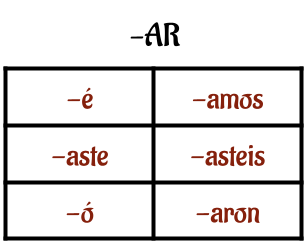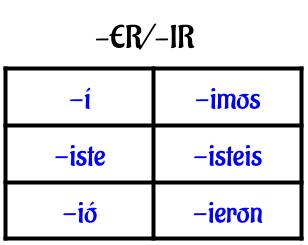El Pretérito Regulares
Here you can watch the instructional video and take notes on the concept, afterward compare your notes with the written explanation found below.
How to form the Preterit Tense
Similar to the other tenses, the first step in communicating effectively in the past, is to first know the verb endings that place the action in the past. The preterit tense forms are formed the same way as the present tense endings. You take of the -AR, -ER, -IR endings and replace them with the endings for the Preterit Tense. See the image below.
Examples with Regular AR verbs:
|
Yo + hablar = hablé
Tú + hablar = hablaste Él/Ella/Ud. + hablar = habló |
Nosotros + hablar = hablamos
Vosotros + hablar = hablasteis Ellos/Ellas/Uds. + hablar = hablaron |
Examples of Regular ER/IR verbs:
|
Yo + comer = comí
Tú + comer = comiste Él/Ella/Ud. + comer = comió Yo + vivir = viví Tú + vivir = viviste Él/Ella/Ud. + vivir = vivió |
Nosotros + comer = comimos
Vosotros + comer = comisteis Ellos/Ellas/Uds. + comer = comieron Nosotros + vivir = vivimos Vosotros + vivir = vivisteis Ellos/Ellas/Uds. + vivir = vivieron |
What is the function of the Preterit Tense?
The preterit refers to the beginning or the end of a past action or to the action as a completed whole The mental position of the observer is beyond the point to which reference is made. Its usual equivalent will be the simple past:
|
hablé I spoke, I did speak; I talked, I did talk
comí I ate, I did eat viví I lived, I did live |
The preterit tense, in telling stories or events in the past, carries the narration and marks the passage of time. They are viewed by the communicator as a completed event in reference to the past.
|
Ella caminó a la tienda y compró leche.
She walked to the store and bought milk. Ellos comenzaron el examen a las tres de la tarde. They began the test at three o'clock this afternoon. Él no vivió en México, vivió en Guatemala. He did not live in Mexico, he lived in Guatemala. |
To be more precise, here three ways in which the Preterit Tense is viewed and used in the language.
|
1) Preterit is used to reference an event or Period beginning and ending.
2) Reference to Completion, or ending
3) Reference to Beginning
|
Here is access to StudySpanish.com where you can practice the conjugations for the Preterit Regulars, Stem-changers and the Spell Changers. On the right you can choose to


